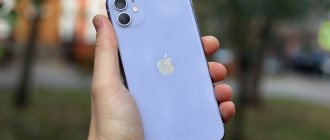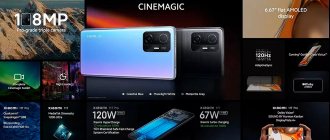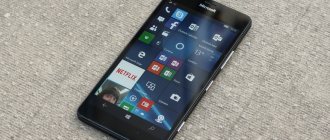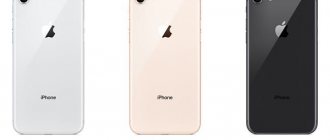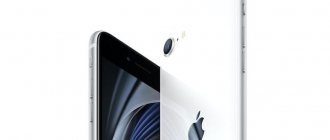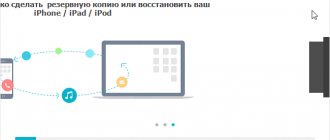All top devices inevitably become objects to be imitated and copied. Apple's iPhone 6 series has not passed the day. The Cupertino team has not released such a commercially successful product before, although it has long firmly established itself as one of the leading companies in the field of computer and mobile technologies.
Soon after the release of the original, numerous, surprisingly similar versions poured out of a cornucopia. Some phones resembled an iPhone only in appearance, masterfully imitating even the interface of a proprietary software shell, while operating on Android. Others did not strive for obvious similarity, and in some technical parameters they even surpassed the “original source”.
However, often excessive “stuffing” negatively affected the performance of the device. Still, Apple products are rightfully considered one of the most stable.
Whatever you say, the company pays a lot of attention to the coherence of the software and hardware parts of the smartphone.
The iX-maxi, from the Russian company teXet, turned out to be surprisingly similar to the Apple smartphone.
The same aluminum body, the protruding peephole of the 8-megapixel camera, an imitation of the Home button (without a built-in sensor that reads the owner’s fingerprints), the same notorious plastic strips above the antennas. From the outside you can't tell the difference right away.
Almost all the ports and connectors are exactly the same as the iPhone 6. The reverse side could even pass for a “six” if it weren’t for replacing the “bitten” logo with the inscription of the manufacturer’s brand – teXet.
The main technical characteristics of the domestic smartphone are as follows:
As you can see, the iX-maxi has a potentially more powerful 4-core processor, but in fact it is far from the capabilities of a dual-core iPhone.
Android, used as an embedded operating system, plays a significant role in this. But he has never been stable. The 4.7-inch iX-maxi is equipped with an IPS display, qHD type, with a resolution inferior to the iPhone (with a matrix of 960 by 540 pixels).
The camera capabilities are also nominally similar: the same 8 MP is the main one, and the front one is even better – 2 MP (versus the 1.2 MP of the iPhone). However, numerous optimizations of hardware and software were not in vain - the camera of the Apple smartphone produces photos with a quality that is head and shoulders above that of the iX-maxi.
The autofocus of the teXet device is slow, this is especially noticeable when shooting in the evening, image stabilization also leaves much to be desired, and the video quality is completely mediocre.
Also, for such a large display, the battery is clearly rather weak - 1600 mAh, versus 1810 mAh in the iPhone. That is, you will barely have enough charge until the end of the day.
What definitely attracts this phone is its reasonable price. It is four times lower than the cost of the iPhone itself. So, on the manufacturer’s website - texet, the device is offered for 11,600 rubles (versus 44,990 rubles). Quite a compelling argument in favor of this model.
In general, the smartphone turned out “a la our answer to the Americans.” But in fact, the Russian device is inferior in technical terms, but there is something to strive for.
Video review: iX-maxiteXet
Meizu MX4
A much more interesting “six-like” phone is the MX4, presented by the Chinese developer Meizu. For its successful execution, it even gained fame as the Chinese iPhone.
The same three types of colors familiar to Apple are available: golden, light and dark gray. The first two have a white front panel, the last one has a black one.
This 5.3-inch smartphone has a lot to please its buyer.
Thus, it is equipped with a powerful 8-core MediaTek MT6595 platform and two gigabytes of RAM. The magnificent capacitive screen - IPS 5.36" produces a clear and rich picture, all thanks to a resolution of 1152 by 1920 pixels. The particularly thin bezels framing the display deserve special praise. This makes the phone look lighter and the image seems to have no boundaries.
It also has 16, 32 or 64 GB of internal memory to choose from.
And taking into account the excellent 20.7 MP camera - SonyExmor RS, in conjunction with the front 2 MP - IMX208, the 64 GB version will be the most suitable to accommodate all high-quality photos. Although the 64 GB model is still not presented on the company’s Russian website. It’s a pity, because traditionally Meizu (as well as Apple) does not make slots for memory cards, so there is no other way to expand the memory capacity. The MX4 battery is quite capacious - as much as 3100 mAh (versus 1810 in the 6, or 2915 mAh in the 6 Plus.) Although, in fact, it can withstand a day of active use, like iPhones.
The system is controlled by Android. Perhaps this is precisely why energy is used so inefficiently, and, in general, a powerful battery quickly runs out.
And again, the price is pleasantly pleasing, almost half less than that of the “American”. So on the Russian website meizu.ru this phone in a minimum configuration is offered for 23,990 rubles.
So this handsome guy can easily compete with the prototype. And it is quite likely that in many respects the comparison will not be in favor of the latter.
Video review of Meizu MX4
Samsung Galaxy S10 - last season's flagship is still relevant this year
It would seem, why use the Galaxy S10 as an example if there is a Galaxy S10e? But if you look at the characteristics, you can see that the physical differences are minimal: the older model with a large screen and frameless design is only slightly larger than its younger brother.
But the Galaxy S10 definitely looks more interesting. Even though it costs more, the smaller Galaxy S10e was not as popular compared to it. The older brother is better in terms of characteristics and design, and given the not very big difference in price, people preferred to pay extra and buy a real flagship. Moisture protection, a fingerprint scanner built into the screen, a 3.5 mm jack, a metal and glass body - the phone is still good to this day.
Lenovo Sisley S90
The Sisley S90 phone from Lenovo also turned out to be very similar to an iPhone. It is clear that the developers of the Celestial Empire company decided to get their share of the hitherto unprecedented glory of the “sixes”.
Judge for yourself: the same smooth rounded lines, wide frames, location of buttons and camera.
Placed between the “sixes” of both sizes, the five-inch Sisley S90 looks like a kind of intermediate mid-size model, and not at all a device from another manufacturer. If it weren’t for the “Lenovo” inscription in the center, you wouldn’t be able to immediately tell that this is not an iPhone.
Of the differences, the first detail that catches your eye is the plastic cover on the top end of the smartphone. Thanks to it, the manufacturer managed to avoid frames in the camera area on an all-metal body.
The second pleasant point is that the camera itself does not rise above the surface of the smooth body.
And third, two SIM cards are supported.
The phone also runs on Android.
However, it is complemented by its own interface developed by the company - LenovoVibe UI. Its “image” on the desktop immediately suggests an imitation of iOS. As for the hardware, the brain of the model is the quad-core Snapdragon MSM 8916 chip from Qualcomm, with a frequency of 1.2 GHz. It provides a quite decent level of device performance.
True, not without freezing, which is typical for all devices running Android (KitKat). Vibe UI has twice as much RAM as the iPhone - 2 GB. Built-in memory - 16 GB/32 GB, there is no possibility of using external cards.
The camera is also decent: the main one is rated at 13 MP, and the front one has as much as 8 MP. Both have their own flashes.
The battery has an optimal capacity of 2300 mAh. Again, it will barely last a day of active use.
Speaking of colors, the typical three colors for smartphones were again offered.
Price tags for the model start at 10,460 rubles for the minimum 16 GB version.
Video review of Lenovo Sisley S90
Ulefone X
The name speaks for itself. This smartphone is so similar to the iPhone X in both appearance and interface design that there is literally nothing to write about here. Well, yes, the hardware is simpler than the two models above. Of course, the cameras are a little worse, and the screen quality is incomparable.
If you look at it with an open mind, the smartphone is worth the money that is asked for it, and its excessive similarity to the iPhone is only an additional opportunity to show off others’ eyes. Isn’t this what most Asian clones of the Apple brand are bought for?
ZTE Blade S6
In the winter of 2015, the Chinese company ZTE introduced another “apple substitute”. The product received a modest name - Blade S6, and a typical iPhone design . The dimensions of the imitator are slightly larger than those of the iPhone: 144 × 70.7 × 7.7 mm, versus 138.1 × 67 × 6.9 mm.
Behind the streamlined shape of the five-inch aluminum body lies a powerful eight-core Snapdragon 615 processor manufactured by Qualcomm. It is based on ARM® Cortex™ A53. The RAM capabilities are also quite good - 2 GB is quite enough. The built-in memory starts at 16 GB; for further expansion there is a corresponding port for a micro SD card. The Blade S6 runs on the Android system, with an adapted user software interface - MiFavor.
The display of the device is quite good, 5-inch HD, created using InCell technology, IPS type (resolution 1280 by 720 pixels). The S6 battery capacity is 2400 mAh, so it will work for a day, like all smartphones of this class.
The cameras have the most common characteristics at the moment: the main one is made by Sony (IMX214) at 13 megapixels, and the front one is at 5 megapixels. The quality of the pictures is acceptable.
The device is designed to use two SIM cards at once, nano format. It has a GPS receiver, supports LTE, Bluetooth 4.0, and Wi-Fi.
It is especially worth noting that the ZTE Blade S6 produces very high-quality sound. To achieve such high results, the manufacturer had to endow its brainchild with a separate audio chip. So music lovers are advised to pay attention to the model.
The price for Blade S6 is $250.
Video review of ZTE Blade S6
Samsung Galaxy S10e - mini-flagship from last year's collection
Last year, Samsung showed a smaller flagship: in terms of characteristics, the Galaxy S10e was slightly simpler than older models, inferior in battery capacity, number of cameras, and the screen received noticeable frames. In terms of performance, it was slightly inferior to the older Galaxy S10. It also has advantages of wireless charging, moisture protection, the usual headphone jack and a slot for a memory card.
HTC One (M8)
Some similarity of features can be seen in last year's flagship HTC-One (M8). This is a spectacular smartphone, the very embodiment of “high-tech”.
It is equipped with a high-quality FullHD display (1080×1920 pixels), and a density of 468 PPI (versus 1334×750, 326 pixels/inch in the iPhone). A sensitive capacitive sensor is responsible for a quick response.
If we consider the design, the HTC OneM8 is a beautiful all-metal gadget. Looks very stylish and expensive. In this sense, the similarity lies not so much in the external image, but in the characteristics and how the device works.
Although in many characteristics the M8 is superior to its competitor from Apple. Thus, HTC is equipped with a more powerful quad-core processor from Qualcomm - Snapdrago n 801.2.3 GHz. (vs. dual-core A8 in iPhone). And it has more RAM - 2 GB, compared to 1 GB. The basic parameters of the built-in memory are 16/32 GB. Of these, 10/26 GB remain free after installing the software shell. The device has a slot for a micro SD card, you can increase the capacity up to 128 GB.
The camera, with HTC's proprietary UltraPixel technology, has a lot of interesting features that not all competitors can be proud of:
Firstly, this is a duet of two main cameras (so-called DuoCamera), to capture the “depth” of the subject being photographed.
Secondly, there is a massive lens with a diameter of 28 mm.
Thirdly, a photomodule with matrix backlighting.
Front camera with wide-angle HDR lens – 5 MP.
The M8 runs Android, with adapted HTC Sense 6.
The manufacturer paid special attention to sound quality. This applies not only to crystal-clear playback of tracks, but also to excellent noise reduction during calls. Moreover, it works in both directions - both to you and from you, sound freed from extraneous noise comes.
A 2600 mAh battery will be able to provide “life” for the smartphone until the end of the day. And in standby mode and rare calls it will reliably last two days.
HTC's color scheme is not very diverse and is quite traditional: silver, graphite and gold. However, there is no point in “painting over” stylish metal.
And again, a much more pleasant price tag awaits you than in the case of an iPhone - 28,690 rubles.
Video review: HTC One (M8)
iPhone XS - last season's top iPhone at a discount
As an alternative to the iPhone SE, I would like to give another iPhone as an example. This is last year's flagship iPhone XS, which fell sharply in price after the autumn presentation at the end of 2022, when sales of the iPhone 11 Pro began. Compared to this, the iPhone XS is not so cool, but it costs much less.
Its advantages are a beautiful case made of steel and glass, a larger display with the same physical dimensions of the device. The offer is good in all respects, except for the price: the new iPhone SE will still be cheaper.
GooPhone i6
Another unconditionally similar appearance is demonstrated by GooPhone i6. In this case, the wording “clone” is even more applicable than just a similar model. It's funny that it came out in the summer of 2014, ahead of the "original source". As we see, Apple cannot do anything about the information leak.
Stick a steel, bitten apple instead of the signature bee, and who’s to say it’s not an iPhone? All the buttons, ports, plastic above the antennas exactly repeat the outlines of the “sixes”
For greater persuasiveness, even the image of the “Apple” shell – iOS – has been recreated. Although in fact the device operates on Android.
The basic package includes a 4-core MediaTek 6582 chip, coupled with 1 GB of RAM. The built-in one, of course, is clearly not enough - only 8 GB, but you can expand its volume by inserting a regular MicroSD card up to 32 GB
You shouldn’t take a larger one to avoid endless lags and system freezes (this isn’t an iPhone, after all).
The 4.7-inch display of the Goophone i6 shows some graininess due to the low resolution of 1280 by 720 pixels.
As expected, there is nothing outstanding in the cameras; the front one is 5 megapixels, the main one is 13 megapixels. It even has autofocus and is equipped with LED backlight. As for the quality of the pictures - of course, you will capture everything you want, but it is very, very far from the level of the iPhone.
A copy of iPhone 6 from Goophone is controlled using Android (adapted from JellyBean). As mentioned earlier, Apple’s proprietary shell images are “prescribed” in it. However, problems associated with Android instability have not gone away.
The battery capacity is not bad at all - 1800 mAh.
You can choose a model in silver, gold or black.
The approximate price range for the gadget is as follows: 7569.78 - 16435.29 rubles. Most likely, you will have to order it from Asian markets, because... This is exactly who the product is aimed at.
Video review of GooPhone i6
It is clear that Apple products set the pace of market development, hence so many imitations. Let's hope that the rapid activity of competitors will finally spur the giant to revise its pricing policy.
All top devices inevitably become objects to be imitated and copied. Apple's iPhone 6 series has not passed the day. The Cupertino team has not released such a commercially successful product before, although it has long firmly established itself as one of the leading companies in the field of computer and mobile technologies.
Soon after the release of the original, numerous, surprisingly similar versions poured out of a cornucopia. Some phones resembled an iPhone only in appearance, masterfully imitating even the interface of a proprietary software shell, while operating on Android. Others did not strive for obvious similarity, and in some technical parameters they even surpassed the “original source”.
However, often excessive “stuffing” negatively affected the performance of the device. Still, Apple products are rightfully considered one of the most stable.
Whatever you say, the company pays a lot of attention to the coherence of the software and hardware parts of the smartphone.
Popular questions and answers
For professional advice on choosing an alternative to the iPhone, the editors of KP turned to Mikhail Alfa, a leading mobile application developer (Moscow).
Which OS is more reliable: iOS or Android?
There is no clear answer to this question. At this time, it all depends on the user of the device, since both operating systems provide the highest level of security “by default.” It’s another matter if you follow suspicious links, download something incomprehensible, or tell someone codes from SMS. A phone, no matter how secure it is, will not protect you. At the same time, in all systems, mobile, desktop, and more specific, there are vulnerabilities that are constantly found and constantly eliminated, the expert says. Some of them are unknown to anyone except small groups of attackers or others, and these vulnerabilities can be exploited to gain remote access to your device without you even knowing about it. But getting into the sample of people who will be of interest to the owners of such technologies is given to few, so if you have no suspicions that you are in this sample, you can rest easy, says Mikhail Alpha.
What is the secret of the unconditional popularity of the iPhone?
The iPhone is really popular, and there are several reasons for this: status, inertia in habits, dependence on the ecosystem, lack of experience interacting with a competing platform that allows you to compare “this and that” and simply satisfaction with the device. I have to say that the wording of the question is somewhat biased. The iPhone is certainly popular, but is it unconditionally popular? Absolutely not. According to statistics, the global percentage of iPhone users is ~26.34%, while the share of Android is ~72.84%. But around everyone there are quite a lot of people who choose iPhone. This may be some kind of statistical distortion, since you are specifically included in the sample of people who have the finances to purchase an iPhone, and your friends are also included in this sample (and no one has canceled consumer loans). The consequence of these capabilities is the belief that everyone has an iPhone. Mikhail Alfa also added that modern flagship Android devices are, objectively, technologically superior to any iPhone. Android has the best mobile cameras, Android has the best displays, Android has the best battery life, Android has unique technical features like an electronic pen. Unfortunately, there are very few devices that combine all these qualities at once, but at least some of them are already enough to be collectively better than the iPhone. The market is not limited to iPhones alone.
iX-maxiteXet
The iX-maxi, from the Russian company teXet, turned out to be surprisingly similar to the Apple smartphone.
The same aluminum body, the protruding peephole of the 8-megapixel camera, an imitation of the Home button (without a built-in sensor that reads the owner’s fingerprints), the same notorious plastic strips above the antennas. From the outside you can't tell the difference right away.
Almost all the ports and connectors are exactly “licked” from the iPhone 6. The reverse side could even pass for a “six”, if not for the replacement of the “bitten” logo with the inscription of the manufacturer’s brand – teXet.
The main technical characteristics of the domestic smartphone are as follows: As you can see, the iX-maxi has a potentially more powerful 4-core processor, but in fact it is far from the capabilities of a dual-core iPhone. Android, used as an embedded operating system, plays a significant role in this. But he has never been stable. The 4.7-inch iX-maxi is equipped with an IPS display, qHD type, with a resolution inferior to the iPhone (with a matrix of 960 by 540 pixels).
The camera capabilities are also nominally similar: the same 8 MP is the main one, and the front one is even better – 2 MP (versus the 1.2 MP of the iPhone). However, numerous optimizations of hardware and software were not in vain - the camera of the Apple smartphone produces photos with a quality that is head and shoulders above that of the iX-maxi.
The autofocus of the teXet device is slow, this is especially noticeable when shooting in the evening, image stabilization also leaves much to be desired, and the video quality is completely mediocre.
Also, for such a large display, the battery is clearly rather weak - 1600 mAh, versus 1810 mAh in the iPhone. That is, you will barely have enough charge until the end of the day.
What definitely attracts this phone is its reasonable price. It is four times lower than the cost of the iPhone itself. So, on the manufacturer’s website - texet, the device is offered for 11,600 rubles (versus 44,990 rubles). Quite a compelling argument in favor of this model.
In general, the smartphone turned out “a la our answer to the Americans.” But in fact, the Russian device is inferior in technical terms, but there is something to strive for.
Video review: iX-maxiteXet
Huawei P20 (Pro)
The Chinese company has been in the news for several months now due to the trade war with the United States. However, this did not stop her from releasing an almost complete clone of the iPhone X, even copying the window for the front camera on top and abandoning the physical buttons in the Pro version.
The only noticeable innovation is three main cameras for increased image clarity. Despite some advantages in image stabilization, this is more of a marketing ploy than a real improvement. The hardware of the device is also beyond praise: a coprocessor for working with neural networks has been added to the powerful Kirin 970, which powers the smartphone.
We can say that Huawei this year has come closest to trying to “move the iPhone to Android.”
Meizu MX4
A much more interesting “six-like” phone is the MX4, presented by the Chinese developer Meizu. For its successful execution, it even gained fame as the Chinese iPhone.
The same three types of colors familiar to Apple are available: golden, light and dark gray.
The first two have a white front panel, the last one has a black one. This 5.3-inch smartphone has a lot to please its buyer. Thus, it is equipped with a powerful 8-core MediaTek MT6595 platform and two gigabytes of RAM. The magnificent capacitive screen - IPS 5.36" produces a clear and rich picture, all thanks to a resolution of 1152 by 1920 pixels. The particularly thin bezels framing the display deserve special praise.
This makes the phone look lighter and the image seems to have no boundaries. It also has 16, 32 or 64 GB of internal memory to choose from. And taking into account the excellent 20.7 MP camera - SonyExmor RS, in conjunction with the front 2 MP - IMX208, the 64 GB version will be the most suitable to accommodate all high-quality photos. Although the 64 GB model is still not presented on the company’s Russian website. It’s a pity, because traditionally Meizu (as well as Apple) does not make slots for memory cards, so there is no other way to expand the memory capacity. The MX4 battery is quite capacious - as much as 3100 mAh (versus 1810 in the 6, or 2915 mAh in the 6 Plus.) Although, in fact, it can withstand a day of active use, like iPhones.
The system is controlled by Android. Perhaps this is precisely why energy is used so inefficiently, and, in general, a powerful battery quickly runs out.
And again, the price is pleasantly pleasing, almost half less than that of the “American”. So on the Russian website meizu.ru this phone in a minimum configuration is offered for 23,990 rubles.
So this handsome guy can easily compete with the prototype. And it is quite likely that in many respects the comparison will not be in favor of the latter.
Video review of Meizu MX4
iPhone SE as reference
We've told you everything we can about the new iPhone SE. A one-of-a-kind small smartphone with the most advanced Apple A13 Bionic chip to date. This means that the iPhone SE will last a long time, will receive iOS updates for four to five years and will be the same people's favorite as the first iPhone SE. Especially when the price is reduced in a couple of years.
Lenovo Sisley S90
The Sisley S90 phone from Lenovo also turned out to be very similar to an iPhone. It is clear that the developers of the Celestial Empire company decided to get their share of the hitherto unprecedented glory of the “sixes”.
Judge for yourself: the same smooth rounded lines, wide frames, location of buttons and camera. Placed between the “sixes” of both sizes, the five-inch Sisley S90 looks like a kind of intermediate mid-size model, and not at all a device from another manufacturer. If it weren’t for the “Lenovo” inscription in the center, you wouldn’t be able to immediately tell that this is not an iPhone. Of the differences, the first detail that catches your eye is the plastic cover on the top end of the smartphone. Thanks to it, the manufacturer managed to avoid frames in the camera area on an all-metal body. The second pleasant point is that the camera itself does not rise above the surface of the smooth body.
And third, two SIM cards are supported.
The phone also runs on Android.
However, it is complemented by its own interface developed by the company - LenovoVibe UI. Its “image” on the desktop immediately suggests an imitation of iOS. As for the hardware, the brain of the model is the quad-core Snapdragon MSM 8916 chip from Qualcomm, with a frequency of 1.2 GHz. It provides a quite decent level of device performance.
True, not without freezing, which is typical for all devices running Android (KitKat). Vibe UI has twice as much RAM as the iPhone - 2 GB. Built-in memory - 16 GB/32 GB, there is no possibility of using external cards.
The camera is also decent: the main one is rated at 13 MP, and the front one has as much as 8 MP. Both have their own flashes.
The battery has an optimal capacity of 2300 mAh. Again, it will barely last a day of active use.
Speaking of colors, the typical three colors for smartphones were again offered.
Price tags for the model start at 10,460 rubles for the minimum 16 GB version.
Video review of Lenovo Sisley S90
Where are the small and powerful Android phones?
I am aware that in the Android world there is a great abundance of phones for every taste and color. But when you want a small device, but with top-end characteristics, the suffering begins. It’s simply a disaster with compact phones; even state phones have grown to obscene sizes, not to mention flagships.
Remember Sony Xperia Compact of different generations?
I was wondering, is it even possible to find a phone similar in spirit to the iPhone SE, but on Android? To also be small, fast, powerful, with an excellent camera for all occasions? So that everything is as we like? It turned out that there is nothing like it in the world. With some stretch, you can choose devices, but these will be compromise options where you will have to put up with larger sizes.
ZTE Blade S6
In the winter of 2015, the Chinese company ZTE introduced another “apple substitute”. The product received a modest name - Blade S6, and a typical iPhone design . The dimensions of the imitator are slightly larger than those of the iPhone: 144 × 70.7 × 7.7 mm, versus 138.1 × 67 × 6.9 mm.
Behind the streamlined shape of the five-inch aluminum body lies a powerful eight-core Snapdragon 615 processor manufactured by Qualcomm. It is based on ARM® Cortex™ A53. The RAM capabilities are also quite good - 2 GB is quite enough. The built-in memory starts at 16 GB; for further expansion there is a corresponding port for a micro SD card.
The Blade S6 runs on the Android system, with an adapted user software interface - MiFavor.
The display of the device is quite good, 5-inch HD, created using InCell technology, IPS type (resolution 1280 by 720 pixels). The S6 battery capacity is 2400 mAh, so it will work for a day, like all smartphones of this class.
The cameras have the most common characteristics at the moment: the main one is made by Sony (IMX214) at 13 megapixels, and the front one is at 5 megapixels. The quality of the pictures is acceptable.
The device is designed to use two SIM cards at once, nano format. It has a GPS receiver, supports LTE, Bluetooth 4.0, and Wi-Fi.
It is especially worth noting that the ZTE Blade S6 produces very high-quality sound. To achieve such high results, the manufacturer had to endow its brainchild with a separate audio chip. So music lovers are advised to pay attention to the model.
The price for Blade S6 is $250.
Video review of ZTE Blade S6
So where can you get a small and powerful Android phone?
This is a problem because gigantomania and display race reign. Manufacturers have succeeded in this: the physical dimensions of phones have long surpassed human capabilities. What I mean is that it is difficult to find a smartphone that would be convenient to operate with one hand; you have to forget about old habits.
I would like to see more compact and powerful models - but, apparently, I’m in the minority and buyers don’t really need such devices. Otherwise, the list of possible candidates for purchase would have been much more impressive.
HTC One (M8)
Some similarity of features can be seen in last year's flagship HTC-One (M8). This is a spectacular smartphone, the very embodiment of “high-tech”.
It is equipped with a high-quality FullHD display (1080×1920 pixels), and a density of 468 PPI (versus 1334×750, 326 pixels/inch in the iPhone). A sensitive capacitive sensor is responsible for a quick response.
If we consider the design, the HTC OneM8 is a beautiful all-metal gadget. Looks very stylish and expensive. In this sense, the similarity lies not so much in the external image, but in the characteristics and how the device works.
Although in many characteristics the M8 is superior to its competitor from Apple. Thus, HTC is equipped with a more powerful quad-core processor from Qualcomm - Snapdrago n 801.2.3 GHz. (vs. dual-core A8 in iPhone). And it has more RAM - 2 GB, compared to 1 GB. The basic parameters of the built-in memory are 16/32 GB. Of these, 10/26 GB remain free after installing the software shell. The device has a slot for a micro SD card, you can increase the capacity up to 128 GB.
The camera, with HTC's proprietary UltraPixel technology, has a lot of interesting features that not all competitors can be proud of:
Firstly, this is a duet of two main cameras (so-called DuoCamera), to capture the “depth” of the subject being photographed.
Secondly, there is a massive lens with a diameter of 28 mm.
Thirdly, a photomodule with matrix backlighting.
Front camera with wide-angle HDR lens – 5 MP.
The M8 runs Android, with adapted HTC Sense 6.
The manufacturer paid special attention to sound quality. This applies not only to crystal-clear playback of tracks, but also to excellent noise reduction during calls. Moreover, it works in both directions - both to you and from you, sound freed from extraneous noise comes.
A 2600 mAh battery will be able to provide “life” for the smartphone until the end of the day. And in standby mode and rare calls it will reliably last two days.
HTC's color scheme is not very diverse and is quite traditional: silver, graphite and gold. However, there is no point in “painting over” stylish metal.
And again, a much more pleasant price tag awaits you than in the case of an iPhone - 28,690 rubles.
Video review: HTC One (M8)
Google Pixel 4 is the benchmark Android with a great camera
At first glance, the phone doesn’t catch your attention: the design is ordinary, even modest, the screen has wide frames, like in the iPhone, the battery is not very large, there is only one SIM card, and there is no fashionable fingerprint scanner built into the screen. But the advantages of Google Pixel 4 are revealed after closer acquaintance: very pleasant vibration feedback, which is rare among Android phones, a smooth and fast interface without unnecessary bells and whistles, and a great camera as a big bonus. Plus, this is one of the few phones with eSIM support, there is moisture protection, and the metal and glass body is pleasant to the touch. A phone for lovers of extraordinary things and connoisseurs of beauty under the Google brand.
Google Pixel 4 compared to other Pixels. Photo: Alexander Pobyvanets / Wylsacom Media
GooPhone i6
Another unconditionally similar appearance is demonstrated by GooPhone i6. In this case, the wording “clone” is even more applicable than just a similar model. It's funny that it came out in the summer of 2014, ahead of the "original source". As we see, Apple cannot do anything about the information leak.
Stick a steel, bitten apple instead of the signature bee, and who’s to say it’s not an iPhone? All the buttons, ports, plastic above the antennas exactly repeat the outlines of the “sixes”. For greater persuasiveness, even the image of the “Apple” shell – iOS – has been recreated. Although in fact the device operates on Android.
You shouldn’t take a larger one to avoid endless lags and system freezes (this isn’t an iPhone, after all).
The 4.7-inch display of the Goophone i6 shows some graininess due to the low resolution of 1280 by 720 pixels.
As expected, there is nothing outstanding in the cameras; the front one is 5 megapixels, the main one is 13 megapixels. It even has autofocus and is equipped with LED backlight. As for the quality of the pictures - of course, you will capture everything you want, but it is very, very far from the level of the iPhone.
A copy of iPhone 6 from Goophone is controlled using Android (adapted from JellyBean). As mentioned earlier, Apple’s proprietary shell images are “prescribed” in it. However, problems associated with Android instability have not gone away.
The battery capacity is not bad at all - 1800 mAh.
You can choose a model in silver, gold or black.
The approximate price range for the gadget is as follows: 7569.78 - 16435.29 rubles. Most likely, you will have to order it from Asian markets, because... This is exactly who the product is aimed at.
Price
In official retail, the Galaxy S10 costs 60,000 rubles, but with discounts and promotions there are offers for 50,000 rubles.
Example of a promotion on Samsung Galaxy S10 with a discount of 10,000 rubles
Traditionally, unofficial prices are even lower; you can fit into a budget of about 45,000 rubles.
Comparison of Samsung Galaxy S10 and Galaxy S20
Alexander Pobyvanets
March 31, 2020

